HISTORIA7: LA TRIQUETRA CELTA. Triquetra (pronounced /traɪˈkwɛtrə/) is a noun derived from the Latin tri- ("three") and quetrus ("cornered"). Its original meaning was simply "triangle" and it has been used to refer to various three-cornered shapes. Nowadays, it has come to refer exclusively to a particular more complicated shape formed of three vesicae piscis, sometimes with an added circle in or around it. This has been used as a religious symbol of things and persons that are threefold.
Triquetra
From Wikipedia, the free encyclopedia
| This article needs additional citations for verification. Please help improve this article by adding reliable references. Unsourced material may be challenged and removed. (March 2010) |
Triquetra (pronounced /traɪˈkwɛtrə/) is a noun derived from the Latin tri- ("three") and quetrus ("cornered"). Its original meaning was simply "triangle" and it has been used to refer to various three-cornered shapes. Nowadays, it has come to refer exclusively to a particular more complicated shape formed of three vesicae piscis, sometimes with an added circle in or around it. This has been used as a religious symbol of things and persons that are threefold.
Contents[hide] |
[edit] Ancient usage
[edit] Germanic paganism
The triquetra has been found on runestones in Northern Europe and on early Germanic coins. It presumably had pagan religious meaning and it bears a resemblance to the Valknut, a symbol associated with Odin.
[edit] Celtic art
The triquetra is often found in Insular art, most notably metal work and in illuminated manuscripts like the Book of Kells. It is also found in similar artwork on Celtic crosses and slabs from the early Christian period. The fact that the triquetra rarely stood alone in medieval Celtic art has cast reasonable doubt on its use as a primary symbol of belief. In manuscripts it was used primarily as a space filler or ornament in much more complex compositions, and in knotwork panels it is a design motif integrated with other design elements. Celtic art lives on as both a living folk art tradition and through several revivals. This widely recognized knot has been used as a singular symbol for the past two centuries by Celtic Christians, Pagans and agnostics as a sign of special things and persons that are threefold.[1]
[edit] Christian use
The symbol has been used by Christians as a sign of the Trinity (Father, Son and Holy Spirit), especially since the Celtic Revival of the 19th century. When modern designers began to display the triquetra as a stand-alone design, it recalled the three-leafed shamrock which was similarly offered as a trinity symbol by Saint Patrick. Some have also suggested that the triquetra has a similarity to the Christian Ιχθυς symbol. The triquetra has been used extensively on Christian sculpture, vestments, book arts and stained glass. It has been used on the title page and binding of some editions of the New King James Version.
A very common representation of the symbol is with a circle that goes through the three interconnected loops of the Triquetra. The circle emphasizes the unity of the whole combination of the three elements.
[edit] Modern use
[edit] Neopaganism
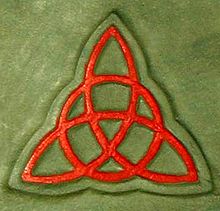
Modern Pagans use the triquetra to symbolize a variety of concepts and mythological figures.
Germanic Neopagan groups who use the triquetra to symbolize their faith generally believe it is originally of Norse and Germanic origins. Due to its presence in insular Celtic art, Celtic Reconstructionist Pagans use the triquetra either to represent one of the various triplicities in their cosmology and theology (such as the tripartite division of the world into the realms of Land, Sea and Sky),[2] or as a symbol of one of the specific triple Goddesses, for example, The Morrígan.
The symbol is also sometimes used by Wiccans and some New Agers to symbolize either the Wiccan triple goddess, the interconnected parts of our existence (Mind, Body, and Soul).
Also the triquetra is a symbol of protection in the Wiccan religion.[3]
It is difficult to date the exact origin of the Celtic triquetra, and whether it was first used in a Christian or pagan context; the distinctive interlace/knotwork artistic style did not fully develop until ca. the seventh century A.D., but the triquetra is the simplest possible knot.
[edit] Popular culture
- The triquetra is often used artistically as a design element when Celtic knotwork is used. Many who identify as Modern Celts may use the symbol to display an identification with Celtic culture, whether they live in the Celtic Nations or the diaspora.
- In recent years, the symbol has become well-known due to its use on the cover of the "Book of Shadows" used by the three sisters on the American TV show Charmed. It represents the three sister witches working together as one.
- A triquetra is one of the four symbols on the cover of the Led Zeppelin album, Led Zeppelin IV, where it used as the personal symbol of bassist John Paul Jones.
- The band Payable on Death (P.O.D.) uses this symbol on most of their CD covers.
- The double triquetra is used to represent the Trinity on The New King James Version Bibles, published by Thomas Nelson, Inc.
- A necklace with a triquetra (Trinity Knot) pendant is used in the film Constantine giving its bearer what was described as being like a bulletproof vest, in the spiritual sense.
- A triquetra is seen on the floor of the laboratory, among other symbols, at the end of the video game Assassin's Creed.
- The TNA clothing brand, exclusive to Aritzia, has a logo composed of three triquetras.
[edit] Geometry
Topologically, the interlaced form of the plain triquetra is a trefoil knot.
[edit] Gallery of variant forms
Triquetra composed exactly of three overlapping Vesica piscis symbols. | |||
Triquetra on one of the Funbo Runestones, located in the park of Uppsala University. | Close-up of a triquetra on one of the Funbo Runestones. |
[edit] See also
[edit] References
- ^ In Search of Meaning, Dalriada Magazine 2001, http://www.celtarts.com/in_search_of_meaning.htm
- ^ Mac Mathúna, Liam (1999) "Irish Perceptions of the Cosmos" Celtica vol. 23 (1999), pp.174-187
- ^ http://www.angelfire.com/moon2/mystique_angel/Symbols.html

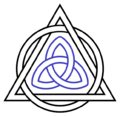
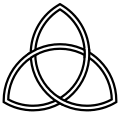
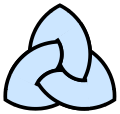
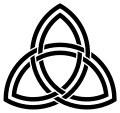
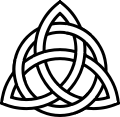
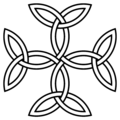


0 comentarios